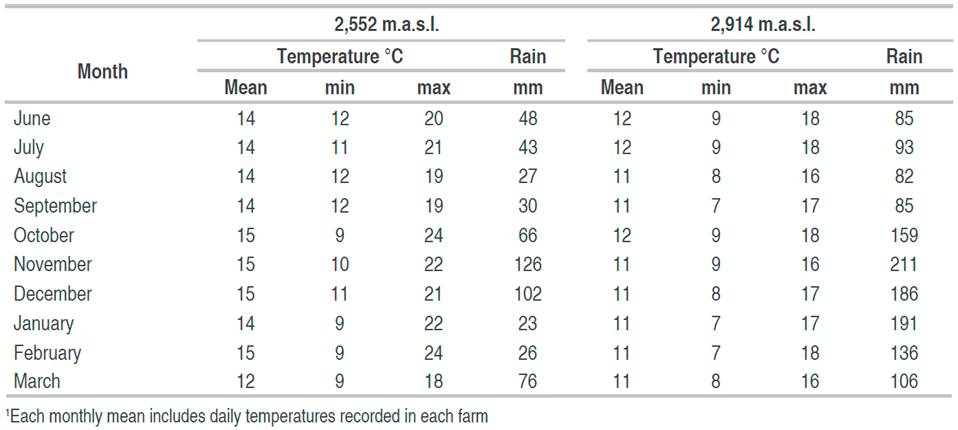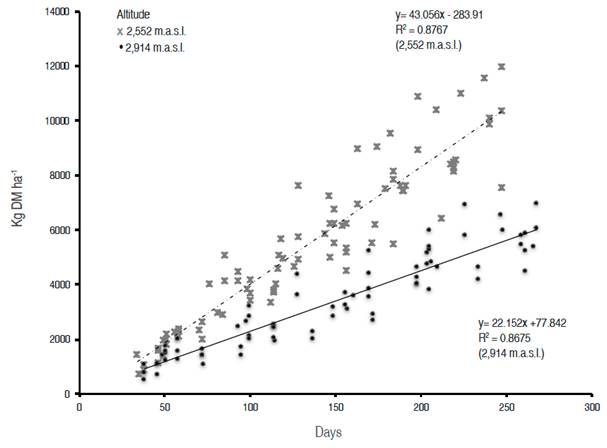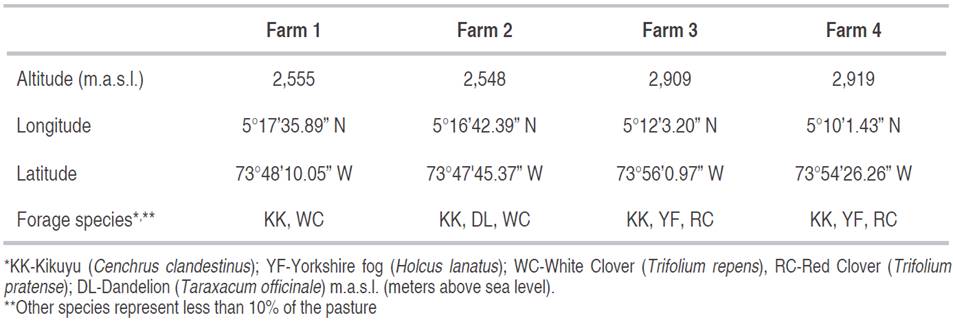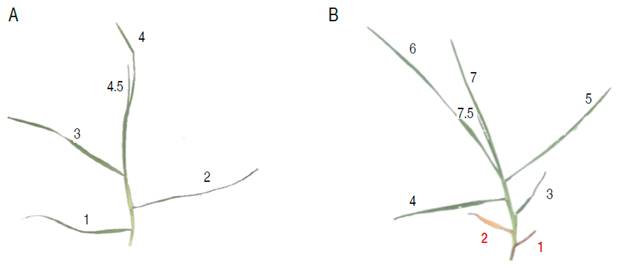Kikuyu grass (Cenchrus clandestinus Hochst. ex Chiov.) is the main source of nutrients for cows in dairy production systems in the high-altitude Colombian Andes; normally, it is managed rotationally with electric fences (strip grazing) (Carulla and Ortega, 2016). This grass grows between 1,800 and 4,000 m.a.s.l. (Giraldo and Cañas, 2013). As the altitude increases, atmospheric pressure, CO2 and O2 concentrations, and average temperatures decrease, while UV radiation and nighttime thermal radiation increase. These changes have a profound effect on plant physiology (Cui et al., 2018), pasture growth, and quality (Wassie et al., 2018). Therefore, pasture management (defoliation frequency) need to be adjusted according to altitude.
For Kikuyu grass, Herrero et al. (2000) found that the time interval at which one new lamina (leaf in a tiller) appears is increased as temperature decreases, as well as the rate of senescence. Therefore, at high altitudes, the pasture growth rate and the senescence will be reduced. These authors suggested that pasture management should consider environmental conditions to determine defoliation frequency, and that the number of leaves per tiller could be an applicable pasture management guideline. This parameter is independent of soil or weather conditions and reflects better pasture maturity (Fulkerson and Lowe, 2002).
Based on forage quality, Fonseca et al. (2016) recommended defoliating Kikuyu in a range between 4.5 to 6 leaves per tiller at 2,560 m.a.s.l. in Boyaca (Colombia). However, the effects of harvesting Kikuyu at different leaves per tiller and different altitudes on dry matter yield (DMY), pasture quality, and annual production of nutrients have not been assessed. The hypothesis was that nutrients would be similar when Kikuyu is harvested at similar stages of growth (leaves per tiller), but at low altitudes, the defoliation frequency will be high, resulting in a higher annual nutrient yield. Therefore, the objective of this study was to evaluate, if regardless of the altitude, the maximum nutrient yield of Kikuyu pastures could be obtained at the same time of defoliation (leaves per tiller).
MATERIALS AND METHODS
Experimental plots and treatments
Four dairy farms located in the Ubaté province at two different altitudes (two at an average height of 2,552±5 m.a.s.l. and two at an average height of 2,914±7 m.a.s.l.) in the Colombian Andean zone were selected (Table 1). In each farm, an area of 75 m2 of Kikuyu pasture was divided into eight plots of 4 m2 each. Plots were separated from the main pasture by an alley of 50 cm, which was mowed continuously during the experiment. The separation among plots was 30 cm wide. Soil samples were taken in each farm close to the experimental area.
Treatments
The experiment consisted of 4 treatments, each of them account for a specific number of leaves per tiller in Kikuyu plants (when the plants presented 4, 5, 6, and 7 leaves per tiller) to proceed with the defoliation. Each treatment was applied in two experimental plots of each farm (two repetitions per farm). Treatments were randomly assigned to an experimental plot, for a total of eight plots per farm (2×4). A 0.25 m2 square was randomly placed in each plot in five consecutive times (1.25 m2) every two days. The leaves in each tiller within the square were counted from the ground to the top. If the first leaf was fully expanded, but the lamina was not complete, it was considered as remaining of the last defoliation and not counted. According to the recommendations of Reeves and Fulkerson (1996) and Jagger (2006), not fully expanded leaves were counted as a half leaf (Figure 1). When the proportion of tillers exceeded 90% of the number of leaves per tiller corresponding to the treatment, the plot was mowed at the height of 5 cm.
Experimental period
Before the experiment, plots were mowed with a scythe at 10 cm height and allowed growing for 42 days. Then, they were mowed again at 5 cm height with a lawnmower (Husqvarna HU550FH) as recommended by Fulkerson and Donaghy (2001); afterward, the experiment began. The experimental period lasted approximately 10 months (between 4 and 8 defoliations depending on the treatment) and conducted from May 17th, 2016 to March 24th, 2017.
Environmental and agronomical variables
Environmental variables. During the experiment, the temperature was measured in each farm with a Datalogger (General® HT50, USA) that made measurements every half hour and stored the information in a USB memory. The amount of rain was measured with a pluviometer (Brixco 4358) in each of the farms, and the readings were recorded every three days (Table 2).
Table 2 Average1 monthly temperatures and rainfall at the two altitudes during the experimental period.

Kikuyo traits. The following variables were recorded when 90% of the tillers in a plot completed the number of leaves corresponding to its treatment.
Undisturbed pasture height (cm): It was measured by placing a metric ruler perpendicular to the ground and a sheet of paper on the canopy of Kikuyu. The distance from the ground to the top of the canopy was considered as the undisturbed pasture height (cm). This procedure was repeated 20 times in each plot before each defoliation.
Interval between defoliations (d): It was estimated as the time between the day of last defoliation and the day when the plant had the number of leaves corresponding to the treatment.
Leaf appearance interval (d): It was calculated by dividing the interval between defoliations (IBD) over the number of leaves corresponding to each treatment (LAI=IBD/number of leaves).
Pasture dry matter (DM): It was estimated by defoliating above ground forage mass in each plot at 5 cm height with a mower equipped with a collection bag. Remaining defoliated grass in the plot that was not collected by the mower was manually recovered with a leaf rake. All the forage harvested in a plot was weight. A sample (1 kg) of the defoliated pasture of each plot was dried in an oven (60 °C for 48 hours) to estimate DM.
Pasture nutritional quality: Dry samples of each plot were ground to a particle size of 0.2 mm in a Wiley type blade mill. Crude protein (CP), neutral detergent fiber (NDF), acid detergent fiber (ADF) and gross energy (GE) in forage samples were determined using Near-Infrared Reflectance Spectroscopy (NIRS) in a FOSS-DS2500 spectrometer (Denmark), with equations validated by the correlation of wet chemistry data of Kikuyu with the scanning of absorption of the samples in the spectrophotometer (NIRS) (Ariza-Nieto et al., 2017). In vitro dry matter digestibility (IVDMD) was determined using the methodology of Tilley and Terry (1963). Digestible energy was calculated from the IVDMD and the gross energy of each sample. The net energy of lactation (NEL, Mcal kgDM-1) was estimated from the estimated digestible energy, according to NRC (2001). The yield of DM, CP, NDF, ADF, IVDMD, and NEL of each plot during the experimental period was estimated by adding the production of a treatment plot in n consecutive defoliations.
Dry matter and nutrient yield (kgDM ha-1): It was estimated considering the area of each plot, the concentration of DM, and the nutrients in the dry matter. Forage DM produced in a plot was calculated by multiplying its fresh weight by its dry matter content. Then, the nutrient produced in a plot was estimated multiplying the produced dry matter by its nutrient concentration. The accumulated yield of DM, CP, NDF, ADF, IVDMD, and NEL of each plot during the experimental period was estimated by adding the production of a treatment plot in n consecutive defoliations. Data of a plot was adjusted to a hectare.
Forage accumulation rate (kgDM ha-1 d-1) calculated dividing estimated DM yield and the treatment interval (kgDM ha-1) by the interval between defoliations (d) (Hunt, 2003).
Statistical analysis
Initially, each group of two farms within the same altitude range was considered an independent experiment. For all variables, data analysis was carried out under a completely randomized block (farms) design with an analysis of variance (ANOVA) (Martínez et al., 2011a). Bartlett test was used to proof the homogeneity of variances between them to determine if these experiments could be grouped (Martínez et al., 2011b). The homogeneity of the variances between altitudes was true; therefore, data were grouped between heights and analyzed as serial experiments (Martínez et al., 2011b), under a completely randomized block (farms) design with analysis of variance (ANOVA), which considered two main effects (number of leaves per tiller and altitude) and their interaction as well as the effect of the farms (block) within the height. The model was:
Where:
Yijk: Response of the i-th plot within the farm, within the k altitude with the number of leaves j treatment
μ: Population mean
ρ: Farm effect
α: Treatment effect (leaves per tiller)
τ: Altitude effect
αi×τj: Effect of the interaction between leaves per tiller and altitude
ρ(τ)ijk: Effect of the interaction between farm and altitude
ε: Experimental error
i: 1, 2 farm
j: 1, 2, 3, 4 treatment
k: 1, 2 altitude.
Data were analyzed using the PROC GLM from SAS version University 2017. Multiple comparisons among means were performed using Tukey's test.
RESULTS AND DISCUSSION
Kikuyu pastures can be found at different altitudes in Colombian Andes and are the main species that support the dairy production systems at high altitudes (Arango Gaviria et al., 2017). Different authors have compared the quality and productivity of Kikuyu pastures harvested at different ages (d) (Ramírez et al., 2015; Correa et al., 2016), but the comparison among studies is not conclusive because of pastures ripe at different rates in different environments (Herrero et al., 2000). Therefore, the same chronological age has a different maturity state depending on the environment in which the grass has been cultivated. Pasture management recommendations such as time of harvest may need to be adjusted to an altitude above sea level.
The number of leaves that can remain green in a grass tiller is determined genetically. This feature has been suggested as a criterion to establish proper harvest time for different grass species to avoid the accumulation of dead material and increase the quality of the harvested pasture (Fulkerson and Donaghy, 2001). Additionally, it may be independent of the environment (Lemaire and Chapman, 1993). Therefore, the appropriate moment to harvest Kikuyu grass pastures may be determined using the criterion of the forage maturity stage measured as the number of leaves per tiller. The present experiment was conducted under natural conditions without fertilization at different altitudes above sea level to determine appropriate harvest time using this criterion.
It has been reported that the altitude generates morphological changes in Kikuyu, and its lamina length is reduced at higher altitudes (Arango Gaviria et al., 2017). Herrero et al. (2000) found that Kikuyu decreases its growth as temperature drops, which occurs at higher altitudes. Lower temperatures reduce leaf elongation rate and increase the leaf appearance interval between them, which resulted in a higher interval (d) between defoliations at the same number of leaves per tiller (Table 3). However, the response to defoliation treatments (leaves per tiller) differs within altitude. At lower altitude, leaves required less time to appear when pasture was defoliated at four leaves per tiller but was similar among leaves per tiller at higher altitude (Table 3).
Table 3 Average interval between defoliation, leaf appearance interval, and undisturbed height of defoliated Kikuyu (Cenchrus clandestinus) pastures with a different number of leaves per tiller (LT) and grown at two altitudes (A) in four farms (F) for 10 months.

As Kikuyu pastures were harvested with an increasing number of leaves per tiller, the undisturbed pasture height increased, but pastures at higher altitudes were shorter (Table 3), a characteristic that may influence animals DM intake (Dobos et al., 2009). At lower pasture heights, the bite-size of the cow decreases, which was compensated by increasing the grazing time (Dobos et al., 2009). There is no consensus on the critical pasture height below which voluntary intake is compromised and if this is independent of pasture species. However, Dobos et al. (2009) suggested that at least a pasture of 13 cm height is required to reach maximum dry matter intake. Other authors found that harvesting the pasture at the height of 10 cm can generate better use of the pasture due to a lower accumulation of stolons within the pasture, favoring the leaf to stem ratio (Sbrissia et al., 2013). At 2,552 m.a.s.l., Kikuyu pastures reached 13 cm when they had between five and six leaves per tiller (Table 3), while, at 2,914 m.a.s.l., it required seven leaves per tiller to reach that height. It suggests that the criterion of leaves per tiller to management Kikuyu pasture may need to be adjusted according to the altitude if desirable pasture heights and yields are the targets.
Leaves per tiller and pasture quality
No interactions were present among treatments number of leaves per tiller and altitude. Therefore, the results of the effect of the treatments or altitude on the nutritional quality of the pasture have been grouped (Table 4). There were no substantial differences in the nutritional composition of pastures associated with the number of leaves per tiller, except for the pastures harvested at seven leaves per tiller where CP and IVDMD were lower (Table 4). The nutritional quality was similar among the other treatments (three to six leaves). Similar behavior was observed for this pasture in Boyacá-Colombia at altitudes of 2,560 m.a.s.l. (Fonseca et al., 2016). It would suggest that Kikuyu pasture could be harvested at a different number of leaves per tiller (three to six) without compromising its nutritional quality at these altitudes.
Table 4 Mean nutrient concentration of defoliated Kikuyu (Cenchrus clandestinus) pastures with a different number of leaves per tiller (LT) and grown at two altitudes (A) in four farms (F) on nutrient yield for 10.

Fulkerson et al. (2010) reported a decrease in crude protein and digestible nutrients after the fourth leaf and suggested that Kikuyu should be harvested between the fourth and fifth leaf since, at this stage, the first leaf that emerges after grazing would begin its senescence faster. The works by Fulkerson et al. (2010) were carried out at sea level and with temperatures higher than those recorded by Fonseca et al. (2016) and the present study. The effect of temperature on maturity rates has been recognized by different authors (Lemaire and Chapman, 1993; Herrero et al., 2000), and it is known that pastures remain with better nutritional quality at low temperatures because they develop slowly. The present results suggest that not only the pasture mature slowly, but the number of leaves per tiller at which senescence starts is also modified by temperature. Apparently, changes in the nutritional composition of Kikuyu pasture do not occur so quickly at greater altitudes above sea level (2,552 to 2,914 m.a.s.l.), senescence occurs later than at sea level.
Curiously, there were small differences in forage protein and ADF due to altitude in the present experiment. CP was slightly higher and ADF lower in the pastures grown at 2,552 m.a.s.l., when compared to those at 2,914 m.a.s.l. (Table 4). These differences may not be important in working conditions. However, higher CP content of tropical forages grown at lower altitudes has been observed by others (Wassie et al., 2018). These authors found that some varieties of Brachiaria brizantha grown at 1,230 m.a.s.l. had higher CP than those grown at 2,650 m.a.s.l.
Pasture DM and nutrient yields
Dry matter and nutrients produced in 10 months were greater for pastures cultivated at 2,552 m.a.s.l. than the ones at 2,914 m.a.s.l., which resulted in higher accumulation rates (kgDM ha-1 d-1) for pastures grown at 2,552 m.a.s.l. However, the effects of the number of leaves per tiller on accumulation rates vary within altitude, which was similar for pastures with different leaves per tiller at 2,552 m.a.s.l. and lower for pastures with five leaves per tiller at 2,914 m.a.s.l. (Table 5). Additionally, the treatment of seven leaves per tiller had the lowest digestibility and protein level, which resulted in a lower yield of digestible nutrients at 2,552 m.a.s.l. for this treatment. Results suggest that Kikuyu pasture is resilient to a more frequent harvest, and that better yields of nutrients (CP, NEL) could be obtained when harvested at five leaves per tiller at 2,552 m.a.s.l. but that at 2,914 m.a.s.l. any of the defoliation treatments would yield similar amounts of nutrients (Table 5).
Table 5 Dry matter, and nutrient yield, and forage accumulation rate of defoliated Kikuyu (Cenchrus clandestinus) pastures at a different number of leaves per tiller (LT) and grown at two altitudes (A) in four farms (F) on nutrient yield in 10 months.

The number of leaves per tiller used to establish harvest time also determines how often the harvest will occur; as the number of leaves per tiller increase, the harvesting frequency decreases. Some authors point out that high grazing frequency could compromise pasture recovery and that the pasture will be depleted over time (Chilibroste et al., 2000). On the other hand, lower harvest frequencies may compromise pasture yield if the light penetration in the canopy is compromised (Da Silva and Hernández, 2010). In the present study, the intervals of time between harvests were 28 to 60 days for 2,552 m.a.s.l. and 48 to 74 days for 2,914 m.a.s.l. depending on the time required for the appearance of leaves in each treatment (Table 3). Despite large differences among treatments between defoliations, and therefore large differences in harvest frequency, the dry matter yield was similar among pastures harvested at different number of leaves per tiller (4, 5, or 6) in 10 months; with exception of the treatment harvested at seven leaves per tiller at an altitude of 2,552 m.a.s.l., where accumulated dry matter yield was lower (Table 5). More frequent grazing (fewer leaves per tiller) also implies lower forage mass at harvest. In our experiment, the mean forage mass at harvest varies between 843 and 1,591 kgDM ha-1 for Kikuyu pastures at 2,552 m.a.s.l. and between 915 and 1,489 kgDM ha-1 at 2,914 m.a.s.l. Pastures harvested at four leaves per tiller at 2,552 m.a.s.l. and pastures with four and five leaves per tiller at 2,914 m.a.s.l. were below 1,000 kg ha-1, value under which forage intake becomes severely limited (Reeves et al., 1996). Therefore, none fertilized Kikuyu pastures should not be harvested at these stages.
Few studies have evaluated the effect of altitude on the accumulated production of dry matter and digestible nutrients depending on the number of leaves per tiller. In Australia, Fulkerson et al. (2010) found that the rate of leaf emergence in Kikuyu grass depended on the first instance of the temperature and that the leaf appearance interval is shorter as temperature rises. We observed that pasture quality varies little between altitudes. The time of a new leaf appearance was shorter for pastures at a lower altitude, indicating that Kikuyu pastures grow faster at higher temperatures, which resulted in a higher growth rate, nutrient yields at lower altitudes (Figure 2).

Figure 2 Accumulated dry matter yield by Kikuyu (Cenchrus clandestinus) pastures grown at two altitudes above the sea level. Each point represents the accumulated yield in one of the experimental plots at a particular point in time.
At higher altitudes, Kikuyu pastures are less productive and need a longer time to recover after grazing. On average, pasture at the higher altitude requires 14 days to be harvested at the same number of leaves per tiller, and each leaf requires almost three days more to appear. Additionally, at the same number of leaves per tiller, nutrient yields will be low, and pasture will require more leaves per tiller to achieve the same yield. In conclusion, altitude affects the growth of Kikuyu pasture, and management should be different depending on the geographic area in which the pasture is established. In farms located at altitudes of 2,552 m.a.s.l., pastures of Kikuyu should be harvested at 5 or 5.5 leaves per tiller to achieve maximum nutrient yields and will require rest periods of 40 to 49 days. Likewise, in farms located at altitudes of 2,914 m.a.s.l., Kikuyu should be harvested from 6 to 7 leaves per tiller and will require rest periods of 64 to 74 d. These recommendations may vary depending on the distances of the pasture to the equator since temperatures will be higher at the same altitude if the pasture is closer to the equator and lower if the pasture is farther.
Finally, the recommendations of the experiment may apply only for Kikuyu unfertilized pastures in the area of the study. It is known that fertilizing with N stimulates the elongation of the leaves (Mejía-Taborda et al., 2014), reaching larger dry matter yields and heights at younger ages. Also, N fertilization modifies canopy structure and may compromise light penetration at a lower number of leaves per tiller. Under these conditions or more fertile soils, Kikuyu pastures may be harvested earlier at a lower number of leaves per tiller.
CONCLUSIONS
The results suggest that unfertilized pastures of Kikuyu in the Ubaté region had a similar nutritional quality when it is harvested with four to six leaves per tiller regardless of the altitude. However, the largest nutrition yields (DM, CP, IVDMD, NEL) and adequate harvest height and mass for grazing will be reached sooner (five leaves per tiller) at 2,552 m.a.s.l. than at 2,914 m.a.s.l. (seven leaves per tiller) due to a higher accumulation rate at lower altitudes (40 vs. 23 kgDM ha-1 d-1). Therefore, it is recommended to harvest unfertilized Kikuyu pasture when it presented five to six leaves per tiller at an altitude of 2,552 m.a.s.l., while, at 2,914 m.a.s.l., it is recommended to harvested when it presents seven leaves per tiller.

















